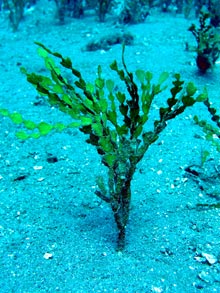
If you were to continuously monitor the pH of water in the open ocean over the course of a day, the graph of your data would be a straight line. Not so for a coral reef system, where the biodiversity and presence of microenvironments found in crevices of the reef make for pH measurements that will vary over a spatial and temporal scale. Dr. Nichole Price, a post doctoral researcher at Scripps Institution of Oceanography, seeks to explain the causes and consequences of the carbonate chemistry variability found in a reef system. Dr. Price was the guest lecturer this past Thursday during the MLML weekly seminar series. Besides bringing a plethora of stunning images from her field research off the coast of the Palmyra Line Islands, Dr. Price spoke on the topic of “Natural variability in seawater pH on a coral reef: causes and consequences for reef accretion and community structure”.
There is natural and predictable variability of pH within a reef , but scientists have only recently begun to document changes within this variability. What remains to be seen is how long term changes in ocean pH will effect calcifying organisms; organisms that make shells and plates out of calcium based compounds. These organisms range in size from microscopic plankton to more familiar macroscopic organisms with shells and even includes calcifying algae. We care about this because as more carbon dioxide is added to the atmosphere, it also increases dissolved carbon dioxide gas in the ocean which may lead to ocean acidification.

Predicted consequences of a more acidic ocean include a shift towards more fleshy algae and away from calcified algae. Calcified algae, along with coral, are “reef builders” who support biodiversity and community structure in the reef environment. Fleshy algae erodes biodiversity in the reef by out competing the coral and creating a more homogenous environment. We do not know a critical value of pH necessary to maintain biodiversity and we do not know the exact consequences of what trespassing that critical value would look like.
By studying the natural variations of pH in a pristine environment like the Palmyra Atolls, one could learn how communities respond and adapt to a decreasing pH and make predictions that could extend to other ocean environments.
The conversation on ocean pH and carbon chemistry continues this Thursday with Chris Harley and his talk “”How will species interactions influence ecological responses to changes in ocean temperature, salinity, and pH?”. As usual, the lecture will be in the MLML seminar room starting at 4:00 pm.

